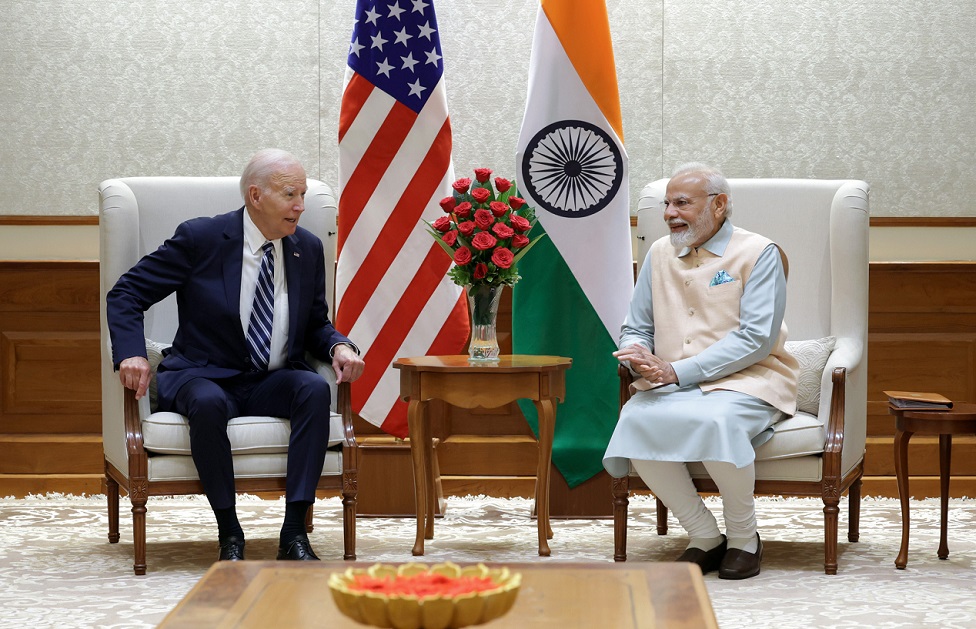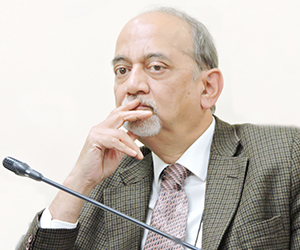Delhi Declaration adopted by G-20 countries has been welcomed by all sides. No less important were a number of bilateral engagements that took place between India and some of the participating countries. They reflect the changing contours of world politics and India’s role in it. President Biden met Prime Minister Modi a day a day before the G20 Summit. He proceeded to Vietnam after the Delhi visit before returning to the US. This represents a major upgrade of the relationship between the two countries to a ‘comprehensive strategic partnership.’ This may reflect a shared concern with China’s policies.
The EU and the US also announced a shipping and railway corridor connecting Asia with Europe via the Middle East. The initiative has been joined by Saudi Arabia. The proposed rail link will run from Saudi Arabia to Israel and will continue by maritime route to Europe. This assumes significance in the context of US efforts to nudge Saudi Arabia to normalize relations with Israel. The EU and the US announced the Trans-African Corridor connecting Lobito port in Angola to DRC and Zambia. China already has a strong presence and has constructed a major railway line.
US-India Bilateral
The joint statement issued at the conclusion of the bilateral Indo-US meeting categorically endorsed India’s candidature for permanent membership of the UN Security Council. This underlined India’s growing stature on the world stage as well as the growing strength of the Indo-US ties.
The US-India Joint Statement also called for continuing work to transform the India-US Strategic Partnership in all its dimensions as well as the importance of the Quad in supporting a free, open, inclusive, and resilient Indo-Pacific.[1] It highlighted Indo-US collaboration in iCET (Initiative on Critical and Emerging Technologies), space, semi-conductor supply chain, 6G and Quantum technologies, defense, and nuclear sectors. President Biden congratulated Prime Minister Modi on the historic landing of Chandrayaan 3 at the South Pole region of the moon as well as the successful launch of India’s first solar Mission, Aditya-L1.
India and the US intend to increase coordination on planetary defence to protect planet Earth and space assets from the impact of asteroids and near-Earth objects, including US support for India’s participation in asteroid detection and tracking via the Minor Planet Center. Two US companies - Macron Technology and Advanced Micro Devices are to invest in India for R&D for building resilient global semiconductor supply chains. Macron Technology has been recently sanctioned by China. The contrast in the approach of the two countries must have been noted by the observers. India offers a far more secure, predictable, and welcoming environment for US investment.
The Indo-US Joint Statement also made a reference to cooperation in the nuclear sector. It reiterated ‘the importance of nuclear energy as a necessary resource to meet our nation’s climate, energy transition, and energy security needs’. Both sides agreed ‘to expand opportunities for facilitating India-US collaboration in nuclear energy, including the development of next-generation small modular reactor technologies in a collaborative mode’.[2]
According to the US Energy Information Agency, ‘With 95,881 MW of nuclear power capacity at 93 operating commercial reactors, the United States has more nuclear capacity than any other country.’[3] There are nuclear skeptics who raise the fear of radioactive waste and accidents to rule out suitability of the nuclear power in India. They need to be reminded that other countries have a much larger nuclear portfolio. Nuclear power accounts for 20 percent of the total power generation in the US. This is much higher than the share of nuclear power in generation in India, which currently accounts for 3 percent. Recently, a new reactor at Georgia’s Vogtle nuclear power plant entered commercial operation in Georgia, USA. Biden Administration has given incentives to the nuclear sector on par with the renewables. They have been given tax credits under the Inflation Reduction Act. ‘Recent legislation, such as the Bipartisan Infrastructure Law and the Inflation Reduction Act, supports U.S. nuclear energy as part of a clean energy, zero-carbon generating portfolio.’[4]
India-Middle East-Europe Economic Corridor (IMEC)
The signing of an MOU on the India-Middle East-Europe Economic Corridor (IMEC) was announced by Prime Minister Narendra Modi on the sidelines of the G20 Summit. He was co-chairing a special event with US President Joe Biden on the Partnership for Global Infrastructure and Investment (PGII) and IMEC.[5] The project ‘would include India, Saudi Arabia, the United Arab Emirates, Jordan, Israel and the European Union.’[6] This will include an ‘Eastern Corridor connecting India to the Gulf region and a Northern Corridor connecting the Gulf region to Europe. It will include a railway and ship-rail transit network and road transport routes.[7]
Ursula von der Leyen, the European Commission President, called the new economic corridor ‘historic’ and said that ‘it will be the most direct connection between India, the Arabian Gulf and Europe till date.’[8] She said that the rail link ‘will make trade between India and Europe 40% faster; with an electricity cable and a clean hydrogen pipeline to foster clean energy trade between Asia, the Middle East, and Europe; with a high-speed data cable to link some of the most innovative digital ecosystems in the world and create business opportunities all along the way.[9]
Trans-African Corridor
Ursula von der Leyen, the European Commission President also announced the Trans-African Corridor, which will connect the port of Lobito in Angola with the Katanga province in the DRC and the copper belt in Zambia.[10]She added that the goal is not only to connect a land-locked region to the sea but also to invest in local value chains, in clean energy and in skills for the local workforce.[11]
China is already present in the region and has built the Benguela Railway in Angola. ‘The 1,344 km railway runs through Angola, from west of the Atlantic port city of Lobito, eastward through cities such as Benguela, Huambo, Kuito, and Luena, and reaches the border city of Luau, bordering the DRC.’[12] The Benguela Railway in Angola is the last section of the 4,300 km railway carrying passengers and freight across the continent. It provides a passenger link between Dar es Salam in Tanzania and Benguela. It also connects Zambia and DRC with the Angolan port of Lobito ‘significantly reducing the costs of resource exports for countries along the line, such as the DRC or Zambia.’[13]
The elephant in the room is China. The connectivity projects are seen as counter to China’s BRI (Belt and Road Initiative) as well as Chinese presence in Africa. China has also built a trans-continental railway line in Africa. Their success will depend on the speed with which they are implemented. There is increasing competition for Africa’s natural resources. China has sought to monopolize them. Copper is needed in the telecommunication sector which will be the backbone of digital connectivity.
President Biden followed up his Delhi visit with a trip to Vietnam. Vietnam upgraded the status of relations with America to a ‘Comprehensive Strategic Partnership’. Hitherto, Vietnam has accorded this status only to Russia, China, and India. The step may reflect Vietnam’s unease with China’s growing assertiveness. Ngyun Phu Trong, General Secretary of the Communist party of Vietnam, said its partnership with the US had grown by ‘leaps and bounds’. Biden described Vietnam as ‘a critical power in the world and a bellwether in this vital region.’[14] Senior executives from Boeing, Intel, Google, Microsoft, and Nvidia participated in a joint US-Vietnam Business Forum. Vietnam Airlines has placed an order worth USD 7.8 billion for the supply of 50 737 Max jets by Boeing. The US companies will invest in resilient, semi-conductor supply chains.[15] While the war in Ukraine grinds on, more attention to Asia and Africa is a welcome change.
Endnotes
[1]The White House (gov), Joint Statement from India and the United States, September 8, 2023 www.whitehouse.gov
[2]The White House (gov), Joint Statement from India and the United States, September 8, 2023 www.whitehouse.gov.
[3]EIA, First new U.S. nuclear reactor since 2016 is now in operation, August 1, 2023
[4]EIA, First new U.S. nuclear reactor since 2016 is now in operation, August 1, 2023
[5]PIB Press Release, 10th October
[6]Al Jazeera, G20 summit: Transport project to link India to Middle East, Europe unveiled, 9 September 2023
[7]PIB Press Release, 10th October
[8]TOI, EU President Ursula von der Leyen calls new economic corridor ‘state-of-the-art connections for the world of tomorrow’, September 9, 2023
[9]European Commission, Statement by President von der Leyen at the Partnership for Global Infrastructure and Investment event in the framework of the G20 Summit, 9 September 2023, www.ec.europa.eu
[10]European Commission, Statement by President von der Leyen at the Partnership for Global Infrastructure and Investment event in the framework of the G20 Summit, 9 September 2023, www.ec.europa.eu
[11]Statement by President von der Leyen at the Partnership for Global Infrastructure and Investment event in the framework of the G20 Summit, 9 September 2023, www.ec.europa.eu
[12]XinhuaNet, Xinhua Headlines: How one Chinese-built railway is igniting economic growth in Africa, 10.10.2020
[13]XinhuaNet, Xinhua Headlines: How one Chinese-built railway is igniting economic growth in Africa, 10.10.2020
[14]Financial Times, Vietnam and US upgrade relations in a move to counter China, September 10 2023
[15]Financial Times, US and Vietnam unveil billions in semiconductors and AI deals, September 11, 2023
(The paper is the author’s individual scholastic articulation. The author certifies that the article/paper is original in content, unpublished and it has not been submitted for publication/web upload elsewhere, and that the facts and figures quoted are duly referenced, as needed, and are believed to be correct). (The paper does not necessarily represent the organisational stance... More >>
Image Source: https://www.pmindia.gov.in/wp-content/uploads/2023/09/H20230908138254.jpg











Post new comment